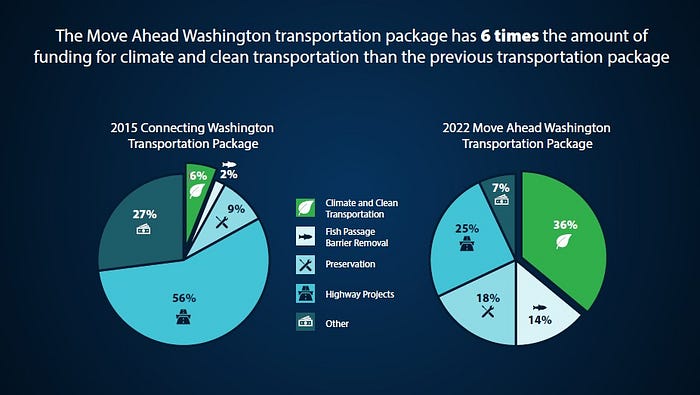Years in the making, one climate bill is allowing legislators to boldly reinvent transportation in Washington. Here’s how.
Gov. Jay Inslee is quick to seize any opportunity to pitch the urgency of climate change.
He’s just as passionate when in meetings with global leaders as when dropping in on a college classroom or bending ears outside a convenience store. He wrote a book 15 years ago about how to build the nation’s clean energy economy and remains every bit as bullish now as he scribbles notes on briefing documents from his staff.
The third-term governor has pursued ambitious policies that some influential voices doubted but have come to fruition in recent years including the nation’s most ambitious 100% clean electricity policy and a nation-leading clean buildings policy. He’s long promoted rapid electric vehicle adoption and made Washington a leading clean tech hub thanks in part to the launch of a state Clean Energy Fund and the Clean Energy Institute at University of Washington.
And this year, his climate action efforts are coming full circle in a big way.
Climate Commitment Act reinvests the price of carbon pollution to pay for climate-friendly transportation programs
Legislators this session approved a 16-year “Move Ahead Washington” transportation package unlike any other in the state’s history. It lays the foundation for a massive shift from simply building more lanes to moving people via cleaner, more efficient transportation options.
“Transportation is our state’s largest source of greenhouse gas emissions. There is no way to talk about climate change without talking about transportation,” Inslee said during the Friday morning signing event for the package. “This package will move us away from the transportation system our grand-parents imagined and towards the transportation system our grand-children dream of.”
A key to the new package? The state’s new cap-and-invest program, created after passage of Inslee’s Climate Commitment Act last year. Inslee first introduced such a policy to the Legislature in 2014.
Washington’s transportation spending is largely funded by the state’s gas tax and state vehicle license fees. The state constitution dictates these revenues can only be spent on highways and highway-related programs.
Cap-and-invest revenue, however, is specifically directed to non-highway projects and programs that reduce climate pollution. The policy also emphasizes equity. At least 35 percent of funds must go towards serving overburdened and marginalized communities.
“Thanks to the Climate Commitment Act passed last year, our cap-and-invest program is providing billions of dollars that we can use to equitably turn the cost of carbon pollution into low- and no-carbon transportation options,” Inslee said. “This is a plan that finally allows us to build for our future.”
Sen. Marko Liias and Rep. Jake Fey chair the Legislature’s transportation committees and led negotiations for Move Ahead Washington. They share the governor’s vision of equitably promoting electrification and significantly expanding options for transit, walking and cycling. Sen. Reuven Carlyle sponsored last year’s Climate Commitment Act legislation.

The Move Ahead Washington package focuses an increased share of funding on maintenance and preservation of existing roads and bridges than prior packages, and includes major projects such as the replacement of the I-5 bridge across the Columbia River. But the clear distinction is how it directs a significant share of investments towards transit, safe bike and pedestrian facilities, electrification of ferries and cars, and other non-highway programs.

The largest share of Move Ahead Washington goes towards climate and clean transportation. The package includes funding for four new hybrid-electric ferries, tens of thousands of new EV charging stations, 25 transit electrification projects across the state, and free fares for passengers 18 and younger on all public transportation.
The package also includes a significant infusion of funding for removing hundreds of fish passage barriers along state highways that block approximately 650 miles of habitat for salmon and steelhead. This work is important to meeting the state’s salmon recovery commitment to Tribes.
Move Ahead Washington will support an estimated 2,390 construction and ferries jobs annually.

The clean energy future can and will be built in Washington state
Among the bills Inslee signed on Friday are several that support the continued growth of Washington state’s clean energy sector. Inslee and legislators advanced policies that promote strong labor standards, protections for overburdened communities, and Tribal rights.

Inslee’s request legislation improves the state’s one-stop siting process for clean energy. This bill modernizes the state’s Energy Facility Site Evaluation Council so it can better support clean energy projects, with up front work and community engagement to site the right project, in the right location, with a more predictable timeline.
In addition, legislators approved the governor’s budget office’s request for expanded tax incentives for clean tech manufacturing, energy storage projects, and additional clean energy sources tied to the strong labor standards first developed under the state’s 100% clean electricity law. The bill will incentivize developers to include high labor standards and hire union workers.
Also on Friday, the governor signed bills that expand the state’s clean buildings policy to include buildings over 20,000 square feet, ensure cleaner, more energy-efficient state buildings, reduce methane emissions from landfills, prevent methane emissions by diverting organic material and food waste from being sent to landfills, and update the Climate Commitment Act.
Though the bill wasn’t part of Friday’s bill signing, the governor will soon be signing one of his request bills that improves government-to-government consultation with Tribes on Climate Commitment Act investments. The bill is a result of a year of work involving the governor’s office, legislators and leaders from Tribes around the state. He’ll also be signing bills that significantly expand access to solar power projects on community buildings and in low-income communities.
Climate & Transportation Bills Signing Events | Flickr



